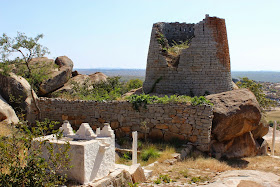Jogikallu Kote was an accidental discovery, it happened while I was scanning the area for Palayyana Kote. The fort got into the itinerary for December 2013.. I was trying to cover some places in Davangere, Chitradurga and Bellary districts.
December 21, 2013
We left Dharwad by 5 AM, reached Ujjini via Gadag, Mundargi and Kottur. Enroute we went across river Tungabhadra, not much water but we could see lot of water birds, four or five big varieties. We had a brief stop at
Ujjaini Matha. During the stop while inquiring about Palayyana Kote, I happened to hear about another fort called
Bairidevara Kote a hill fort. Though Bairidevara hill was a short climb I chose to take pictures of the fort from distance because of time constraint. Next we moved on towards
Palayyana Kote.. reaching the base of the hill by vehicle was not possible, and the distance was bit too much to cover by foot. Again I took pictures from a distance. Next was Jogikal Gudda.. though it was past 1 PM we decided to explore the hill first and then have lunch.
Halae Jogikallu is a small village next to a rocky hillock of the same name. The name Jogikal can be split into Jogi and Kallu. Jogi means Yogi, I think. It is possible that a Shiva Yogi stayed on the rock hill hence the name. Going by the look of the hill it seems like a prehistoric site. So, here we are at the fort entrance.. we walked about a kilometer through the village streets to reach this spot.
The fort entrance has been renovated recently.. looks like this is an important shrine in this region. This bastion is besides the fort entrance.
To the other side is a steep face and more bastions.
We climb up to a high point.. fort entrance, the crumbling bastion and the village below.
This bastion is probably the highest one. Looks like it was built between 600 to 1000 years ago. It might have been used to store food and weapons.
Another bastion in the background, that could be the far end of the fort. All bastions give a commanding view of the neighbouring plains and hills.
This bastion proves that ancient people were always in synch with Nature. When they had the ability to break and move rocks, this boulder could have been broken but builders chose to leave it intact and made it part of the structure. Wonderful creation!
These two boulders might have been one centuries ago. Note the chequered cracks on the right boulder.
The shrine; its a group of several temples.
This place has been recently tidied up and painted, probably a fair was held days or weeks ago.
To the right of this bastion is a small gateway, an exit to the outer fort.
The gateway.
The bastion as seen from the outer fort. Note the row of slits for firing arrows or guns.
We are the far end of the fort, probably the southern tip. Accessing the fort from these slopes is not easy.
Kote Kere ~ fort's water tank. Paddy is the main crop in this region. Paddy had been harvested and village folks were busy running the stalks through portable machines to separate the grains from the stalks.
Being a rock hill, it will have its share of natural shelters. Here's one we could see easily. There could be many more we missed.
I went into the shelter.. there's a window to the other side of the hill.
Beautiful. A valley down there. With good rain fall this place will be a wonderful sight. To the left a small flat surface can be seen.. It looks like a good sentry point. The spot could also be a good spot for a yogi to meditate.
I loved the place, as much as its name.. J o g i k a l. I wish I had more time to explore in detail.. we might have found a rock painting or a petroglyph hidden some where.. Well, time to leave, our tummies were growling.
Jogikal is a kilometer from the main road. We came back to the main road, found a shady spot with lot of clean rocks and settled down for home made lunch.. jolada rotti, chatni, sprouts, cucumber, carrot, tomato and curd. Our next destination was Kumati to see the prehistoric
anthropomorphic statues.
Jogikal Kote Coordinates: 14°58'1"N 76°27'6"E
.........























































